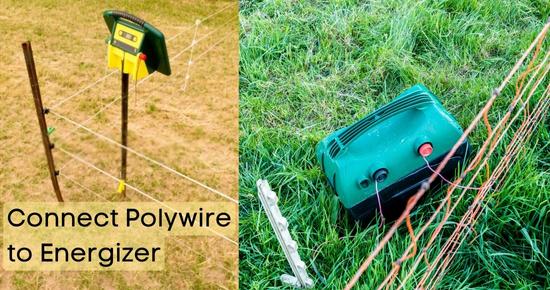The wire connected to the energizer should be of higher quality than the fence wires. But if you have installed a poly wire electric fence, you can use poly wire to connect your energizer to the fence and the ground rods.
Polywire is helpful for temporary or portable fencing as it’s easy to install and remove from the energizer. While for permanent fencing, you should use high-quality insulated metal wire.
A fence energizer has two types of terminals or wires. Input wires carry current from a power source(AC/DC) to the energizer.
The output wires carry current from your energizer to the fence and back through the ground rods.
We’ll connect the energizer’s live output terminal to the fence wire and the ground terminal to the ground rods.
This post teaches you how to join the poly wire to the fence charger.
How to connect the poly wire to an energizer?
For connecting poly wires to the fence charger:
- Take two pieces of poly wire long enough to reach from the energizer to the fence strands and ground rods.
- For better connectivity in conductors expose the metal filaments of poly wires by burning both ends at least 3-4 inches.
- Then unscrew the live terminal, twist the filaments around the terminal & tighten it again. Knot the other end(filaments) to a live fence strand.
- In the same way, attach the second poly wire between the energizer’s ground terminals and a grounding rod.
- A Polywire connector is also useful for connecting a poly wire fence to the charger. Unscrew the nut on the connector. Adjust any fence strand under the connector’s plate. Insert another wire in the plate that connects to the fence charger. Secrew the nut again.
Tip:
- Burning the poly wire’s ends will ensure a secure connection between conductors and better current conductivity in your fence.
- It’s recommended to use a highly conductive and insulated wire to connect the energizer. However, if using poly wires, use a thicker one with more metal strands.
Step 1: Take two poly wires and burn their ends
- Measure the distance from the energizer to the fence wires. Also, measure the distance from the energizer to the ground rods. Cut two pieces of poly wires for the measured distance(a little extra for safety).
- Burn ends of the poly wires at least 3-4 inches with a lighter, depending on the diameter of the energizer’s terminal. The poly wire’s plastic fibers will melt, exposing the metal filament.
- If you directly connect a poly wire(without burning ends), the metal strands/filaments may not securely attach to the energizer’s terminals and reducing the.
Tip: A poly rope/wire with more strands will be helpful. It’s recommended to use a high-quality wire to connect the energizer.
Step 1: Understand the wiring
A fence energizer has two output terminals, live and ground.
The live terminal is usually red(🗲) and gets connected to the live fence wires.
The black ground terminal(⏚) gets connected to the ground rods.
How the electric fence circuit will work:
- The live terminal of the energizer generates voltage pulses that are carried to the fence strands.
- The circuit remains incomplete until someone touches the fence wires.
- Current leaks into the soil & travels toward the ground rods.
- From ground rods current travel back to the energizer, completing the circuit.
Note: Never use poly wire at the input terminals of the energizer. Input terminals receive power from an AC or DC source. So a highly conductive & insulated wire should be used.
Step 3: Connect the poly wire to the energizer
Connect the energizer’s live terminal to live fence wires:
- To ensure secure connections between conductors, expose the metal filaments by burning both ends of the poly wire at least 4 inches.
- Now unscrew the energizer’s live terminal.
- Tightly twist(rotate) the metal strands from one end of the poly wire around the energizer live terminals.
- Retighten the energizer terminals.
- Knot the filaments of the other end of the poly wire to one of the live fence strands.
Connect the energizer’s ground terminal to the ground rods:
- Similarly, take another wire & burn it’s both ends.
- Unscrew the energizer ground terminal.
- Twist the filaments of one end of the poly wire around the terminal & screw it back.
- Unscrew the nearest ground rod clamp. Insert the polywire filaments inside it & screw the clamp again.
- Ensure the poly wire is tight & not touching the ground, grass, or anything metal that can create a short circuit/power loss.
- At last, slightly pull the poly wires to ensure the connection is secure.
Remember: A single loose connection will increase resistance & reduce around 500 voltage from your fence.
Precautions:
- A highly conductive & insulated wire should be used to connect the energizer. However, if you have a low to medium-power energizer, then you can use a poly wire to connect the energizer’s terminals to live fence wires & ground rods.
- If you directly connect the poly wire to the energizer’s terminal without burning the ends(exposing conductor strands), soft polyethylene fibers may slip & the metal filaments will not connect well. Hence a poor connection will reduce your fence power.
- If the poly wire is loose (hanging low), it’ll be short-circuited with soil, grass, or metal objects nearby & fence power will escape.
- Hang your fence charger at a height, so animals can’t reach it. and don’t let the poly wire touch the ground(tighten them).
Conclusion
If you’re using poly wires to connect your energizer, it’s highly recommended to expose the metal filaments in the poly wire by burning its ends. Exposed metal strands ensure a secure connection between conductors, hence improving current conductivity & fence power.
However, a thick highly conductive & insulated wire should always be used to connect the energizers.
Still need any guidance, ask us in the comments below.

